

|
Astronomy 162:
Introduction to Stars, Galaxies, & the Universe
Prof. Richard Pogge, MTWThF 9:30
|
Lecture 40: The Once and Future Sun
- Solar Evolution
- The Sun is a middle-aged, low-mass, main-sequence star
- Its future evolution can be computed using stellar models
- The Main Stages of the Sun's Life
- Main-Sequence Star
- Red Giant Star
- Horizontal Branch Star
- Asymptotic Giant Star & Unstable Pulsations
- Planetary Nebula Phase
- White Dwarf
The Fate of the Sun
Question: How will the Sun evolve?
To answer this question, astronomers have made detailed
calculations including:
- State-of-the-Art Stellar Evolution codes
- Detailed Solar Structure Model
- Inclusion of realistic mass-loss processes
The goal is to produce a self-consistent model of the Sun that will
trace its evolution from the time it reached the Main Sequence until its
emergence as a hot white dwarf.
In preparing this lecture, I have drawn on two relatively recent
calculations of detailed Solar Evolution models:
- Sackmann, Boothroyd, & Kraemer (1993), Astrophysical
Journal (Vol. 418, 457)
- Bahcall, Pinsonneault & Basu (2001), Astrophysical Journal,
(Vol. 555, 990)
The Sun Today
The Sun is currently a middle-aged, low-mass star on the Main Sequence.
Properties:
- Age = 4.55 Gyr
- Mass = 1 Msun = 1.99x1033 g
- Radius = 1 Rsun = 700,000 km
- Luminosity = 1 Lsun = 3.83x1026 Watts
- Temperature = 5779 K
- ~50% of its core Hydrogen has been fused into Helium
The Sun at this time is in a state of
Hydrostatic and
Thermal Equilibrium.
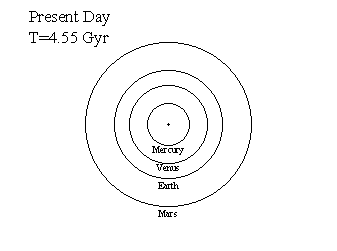
- Note: This and subsequent pictures show the inner solar system with
the Sun drawn to scale with respect to the orbits of the planets. The
scale is also the same between each solar system graph, so you can see how
much the planets move outward as mass loss proceeds.
"Quiet Adulthood"
The Sun took about 50 Myr to form from a molecular cloud core.
It reached the Main Sequence about 4.50 Gyr ago. When the Sun first
alighted onto the Zero-Age Main
Sequence it was
- A little fainter: 0.70 Lsun
- A little smaller: 0.897 Rsun
- A little cooler: 5586 K
than we see today.
The Sun can maintain itself in Hydrostatic and Thermal Equilibrium as
long as it can stably burn Hydrogen into Helium in its core.
As the Sun consumes its core Hydrogen, it slowly grows brighter with
age. We see a brighter, hotter, and slighly bigger Sun today than
when it formed. This trend will continue so long as the Sun is on the
Main Sequence.
Mid-Life Crisis for the Earth
The steady brightening trend will spell trouble for the Earth in the
distant future.
5.6 Gyr (1.1 Gyr from today):
- Sun 10% brighter: ~1.1 Lsun
- The extra sunlight triggers a Moist Greenhouse Effect.
A "Moist Greenhouse Effect" is one in which most of the water in the
atmosphere is driven off into space. This will likely mean the end of
large surface life on Earth, though some types of marine life and
simpler lifeforms might survive in the deep oceans or underground.
Venus on Earth
The warming trend will continue through the Sun's Main Sequence phase.
9 Gyr (3.5 Gyr from today):
- Sun 40% brighter: ~1.4 Lsun
- Extra solar energy triggers a Runaway Greenhouse Effect
The oceans will totally evaporate into space, releasing all of the
Carbon Dioxide (CO2) currently locked up in marine sediments
into the atmosphere. The result will be to turn the Earth's moist,
light, warm atmosphere today into a hot, heavy, bone-dry CO2
atmosphere like that on Venus today.
Hydrogen Core Exhaustion
11 Gyr (5.5 Gyr from today):
The Sun's core runs out of Hydrogen, most of the volume of the core
having been replaced by inert Helium "ash".
- The Inert He core starts to contract and heat up
- H burning moves out into a shell
- T = 5517 K
- R = 1.575 Rsun
- L = 2.21 Lsun
The Sun leaves the Main-Sequence and becomes a Sub-Giant star.
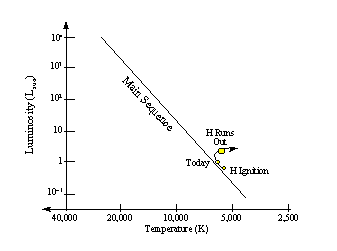
"Lively Old Age"
The Next 0.7 Gyr:
- Sun expands a near-constant Luminosity of about 2.2 Lsun towards
the base of the Red Giant Branch.
- Sun swells in size from 1.58 Rsun to 2.3 Rsun
- Surface layers cool from 5517 K to 4902 K
This growth is accompanyied by the start of slow mass loss in a stellar wind:
- The wind steadily picks up as the Sun approaches the base of the Red Giant
Branch
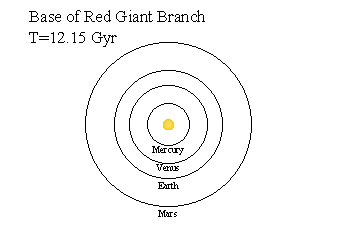
Climbing the Red Giant Branch
It will take the Sun about 0.6 Gyr to climb up the Red Giant Branch.
During this time, the Sun will lose up to 28% of its total mass in a strong
stellar wind.
- This mass-loss causes the planets to move outwards a little:
- Venus moves out to about 1 AU (where Earth is now)
- Earth moves out to abou 1.4 AU (about where Mars is now)
- The other planets also move out similarly.
All the mass-loss occurs from the outer envelope.
At the Tip of the Red Giant Branch, the outwards appearance of the Sun
is as follows:
- T = 3107 K (M0 III Star)
- L = 2350 Lsun
- R = 166 Rsun (0.775 AU)
The Sun's swelling red-giant envelope will swallow Mercury!
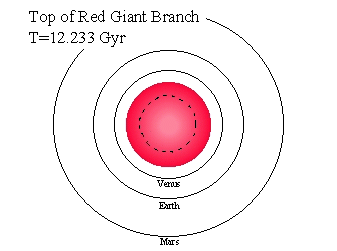
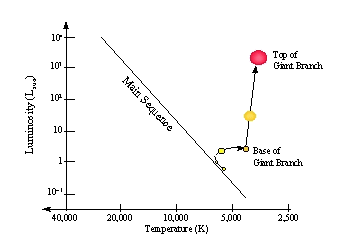
The Helium Flash
When the Sun reaches the Tip of the Red Giant Branch:
- Helium Burning to C & O ignites rapidly in a
Helium Flash.
- Extra energy stablizes the core against collapse.
- Commences Hydrogen Burning in a thin shell outside the He burning core.
The Sun descends quickly onto the Horizontal Branch in about 1 Myr
as it rearranges its internal structure to accomodate this new source of
energy.
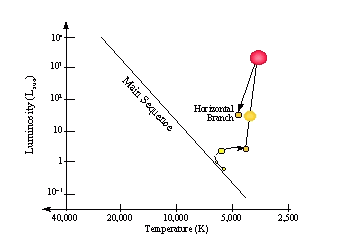
The Horizontal Branch
With a new source of energy (He fusion), the Sun settles onto the
Horizontal Branch for
a brief "retirement" period of Hydrostatic and Thermal Equilibrium:
- Radius: R=9.5 Rsun
- Temperature: T = 4724 K
- Luminosity: L = 41 Lsun
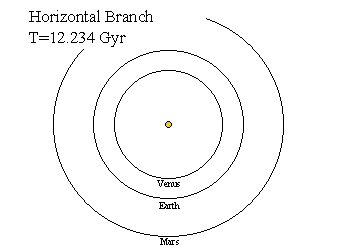
However, because He fusion is about 100-times less efficient at
producing energy per reaction than H fusion, the Sun can only keep this
up for about 100 Myr...
An All-Too-Brief Retirement
After 100Myr, the Sun runs out of core Helium, and slips out of
Equilibrium again:
- C-O "ash" core begins to contract and heat up
- Remaining He is displaced into an He-burning shell, surrounded
by a thin H-burning shell.
The Sun starts to swell up & get brighter:
- R = 18 Rsun
- T = 4450 K
- L = 110 Lsun
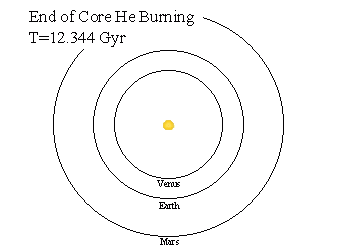
Helium Core Exhaustion
Driven out of Hydrostatic and Thermal Equilibrium by exhaustion of He in
the core, the Sun now begins to climb the Asymptotic Giant Branch.
This process is rapid, taking only about 20 Myr:
- The C-O core steadily contracts and heats up.
- Fusion is moved out into a He burning shell
- A thin H burning shell sits outside the He-burning shell.
During this time, the Sun swells up rapidly, getting cooler & brighter:
- R = 180 Rsun (0.84 AU)
- T = 3160 K
- L = 3000 Lsun
Note that this is brighter than when it climbed the Red Giant Branch
before, and it happens much faster than before (20 Myr compared to 0.6
Gyr).
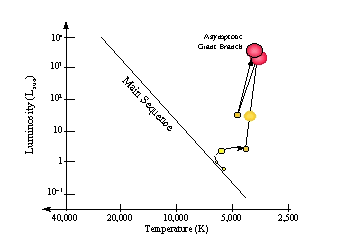
AGB Phase Mass Loss
The Sun's ascent of the Asymptotic Giant Branch is also accompanied by
mass loss in the form of a strong stellar wind:
- The Sun's mass is reduced to about 0.6 Msun
The surviving planets (Mercury was engulfed during the Red Giant phase)
move further outward:
- Venus moves out to 1.22 AU
- Earth moves out to 1.69 AU
- The others move out proportionally...
Near the tip of the AGB, thermal pulsations in the envelope begin.
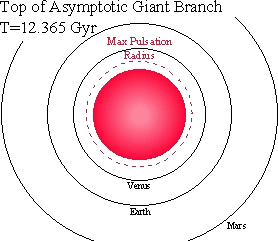
The Tremors of Old Age
As the Sun nears the tip of the Asymptotic Giant Branch, unstable thermal pulsations
begin in the He-burning shell:
- Models predict 4 pulses at roughly 100,000 year intervals.
- Each pulse puffs the Sun up to 213 Rsun (about 1 AU!)
- The largest is pulse #4, with L = 5200 Lsun!
These pulsations will progressively eject most of the remaining envelope
of the Sun.
Each episode of pulsational mass-loss causes the surviving planets to
move further away from the Sun.
A Final Flowering
The last of the thermal pulses blows off what is left of the envelope
over the course of a few thousand years.
As the last of the envelope comes off, the hot C-O core of the Sun
is unveiled. As seen from the outside:
- T goes from 4000K (envelope) to 120,000K (bare core)
- L stays constant at ~3500 Lsun
- The bare core rapidly traverses the H-R diagram
UV photons from the core ionize the ejected envelope gas, forming a
Planetary Nebula
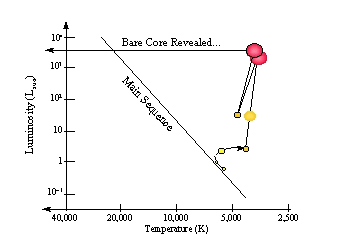
Actually, there is some controversy about this. The minimum stellar
mass needed to get a planetary nebula stage is not known, mostly because
of uncertainty about how much mass is lost during the stellar wind
phases, and how that effects the evolution of the bare core plus
expanding envelope. There are two possiblities: One is the scenario
above where the Sun briefly flowers as a Planetary Nebula, the other
where the envelope dissipates before the core gets hot enough to ionize
it and light up the nebula. There is currently no concensus.
The Final Configuration
The bare core, now with a Mass of about 0.54 Msun, evolves
into a slowly cooling
White Dwarf with a radius
a little smaller than the Radius of the Earth.
With mass loss now ended, and the final mass of the white dwarf fixed,
the surviving planets settle into their essentially final orbits:
- Venus is at 1.34 AU
- Earth is at 1.85 AU
- Mars is at 2.8 AU
- and so forth...
The planets will continue orbiting the remnant white dwarf in this
configuration unless a passing star happens to come close enough to
disrupt their orbits.
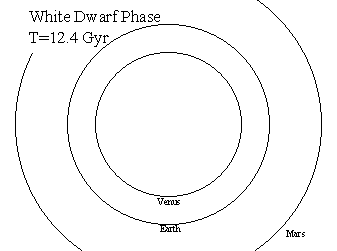
The white dwarf that was the Sun now begins a long, slow cooling phase
that will last for nearly a Trillion years as it fades away into a long
night.
The Seven Ages of the Sun
- 1 Msun Main-Sequence Star: 11 Gyr
- Red Giant Star: 1.3 Gyr
- Horizontal Branch Star: 100 Myr
- Asymptotic Giant Branch Star: 20 Myr
- Thermal Pulsation Phase: 400,000 yrs
- Planetary Nebula Phase: ~10,000 yrs
- 0.54 Msun White Dwarf as the final state.
Return to [
Unit 6 Index
|
Astronomy 162 Main Page
]
Updated: 2006 March 5
Copyright © Richard W. Pogge, All Rights Reserved.













